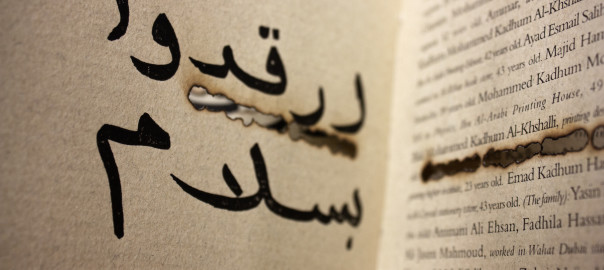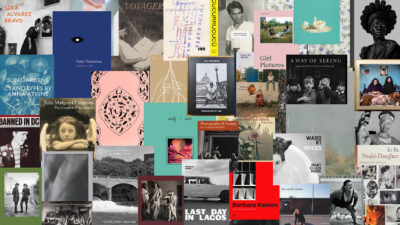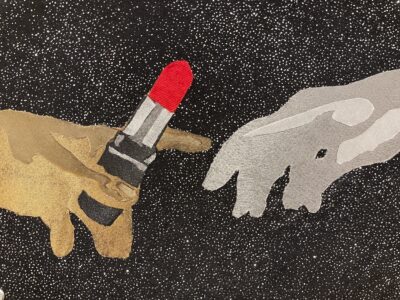Fenwick Gallery / Special Collections and Archives Exhibitions
Poetry

Super Orphan by Fatimah Asghar
Artists’ Books
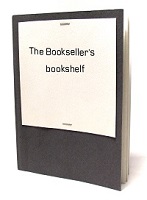
Amber Ablett, UK
The Bookseller’s Bookshelf
2013; Ed. of 3
Paper, card, words
210 x 148 mm
The Bookseller’s Bookshelf is a portrait of Sebastian Sandys, the proprietor of LXV Books, an independent bookshop in Bethnal Green in London. The work is made up of the first page of the books that are presently on Sandy’s’ bedside book shelf, and explores the idea that who we are can be described through what we choose to read; these books inform our language, attitudes, beliefs and understanding of the world around us.
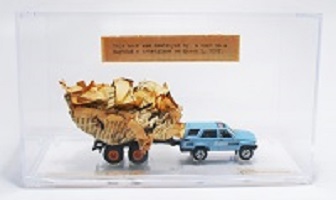 Helen Allsebrook, UK
Helen Allsebrook, UK
It is what it is…
2012; Ed. of 3
Child’s toy car and trailer, pages from an ‘unwanted book’, Perspex case
21.5 x 9.5 x 12 cm
This response to the 2009 Jeremy Deller’s tour of the car bomb remnants that blew up al-Mutanabbi Street is a focus for discourse, standing as a metaphor for the rich historical knowledge lost and acting as a cenotaph to the absent lives. By presenting the work in a typical museum display box, the artist aims to promote a feeling that this is a time capsule – the significance of which is never to be forgotten. Like Deller’s tour, it aims to heighten public understanding of war’s realities, targeting voyeurs who had been observing through the safety of media.
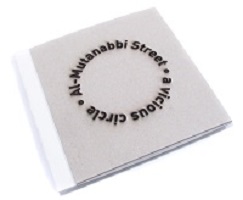
Mette-Sofie D. Ambeck, DENMARK
Al-Mutanabbi Street – A Vicious Circle
2012-13; Ed. of 10
Grey board, Fabriano 160gsm, pamphlet stitched
20 x 20 cm
This book’s form seeks to represents the idea of history, like the circular design of the city of Baghdad and its continually regenerating conflict, as cyclical. Al-Mutanabbi Street–A Vicious Circle not only portrays the bleak cycle of war, but also celebrates al-Mutanabbi Street’s ever-unfolding history as a place where thoughts and ideas can be exchanged in book form.
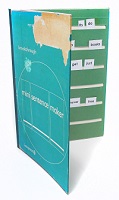 Karen Apps, UK
Karen Apps, UK
A nation will fall into ruin if its people do not read books: Breakthrough to Literacy
2012; Ed. of 3
Inkjet prints, paper, cardboard
6.5 x 24 cm
A book carries ideas accessed through literacy. The written word allows us the freedom of turning thought into text, sharing ideas with others, learning. The Breakthrough to Literacy folder references the present shortage of books and texts available to libraries, schools and universities in Iraq. Each book contains the same words to create one of three quotations relating to the act of reading. The words are not fixed and there is the potential to make new meanings.
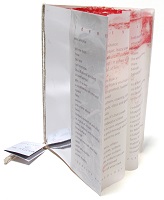 Zsuzsanna Ardo
Zsuzsanna Ardo
Looking at the Ice Seller
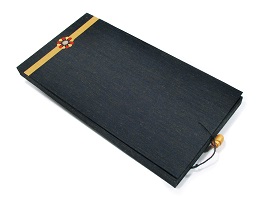 Tania Baban with Jim Natal, USA/ARGENTINA;USA
Tania Baban with Jim Natal, USA/ARGENTINA;USA
The Street of the Poet
2011; Ed. of 8
Japanese book cloth, iridescent & gold ink
Text: Jim Natal, Conflux Press
5.5 x 11” (closed), 5.5 x 22” (open)
Influenced by Islamic illuminated manuscripts, Baban connects her work to the manuscripts destroyed in the 12th century sacking of Baghdad by the Mongols, while remaining present in the 2007 car bombing. The medieval style references both original 12th century manuscripts and the vintage volumes and Korans lost in the 2007 blast.
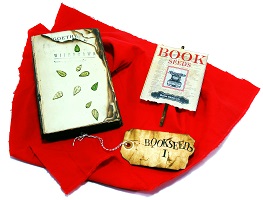 Nancy Bardos and Judy Novak, USA
Nancy Bardos and Judy Novak, USA
We Shall Always Return and Book Seeds
2013; Ed. of 3
Deconstructed book, inks, handspun Uruguayan wool, clay, book pages, adhesives, graphic designed seed packet, constructed envelope, wooden drink stirrer
10 ¾ x 18 x 10”; 7 ½ x 5 x 8”
We Shall Always Return and Book Seeds I and II, honors the human lives lost and the unimaginable suffering that occurred that day. Bardos pays homage to the sharing of ideas and the freedom of exploring cultures, opinions, art and history that the al-Mutanabbi Street book lovers hungered for and embraced.
 Lucy Baxandall, UK
Lucy Baxandall, UK
Empty Shelf
2013; Ed. of 4
Handmade pigmented linen paper, inkjet print, inks
17 x 8 cm (closed), shelf depth 2.5 cm
This booklet, meant to be carried and handled, is made from worn household linens brought to the United Kingdom from Germany by Baxandall’s mother’s refugee in the 1930s. The text was sparked by an al-Arabiya video report documenting the 2012 government raid.
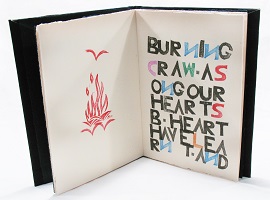 John Bently, UK
John Bently, UK
The Song Lives On
2011; Ed. of 3
The Song Lives On is a project that has grown over time to represent the Freedom of Speech. Bently, prompted by the execution of Nigerian writer Ken Saro Wiva, started writing this song in 1995. The text of this song, approximately 100 words, is in constant mutation, changing slightly each time it is rewritten or sung.
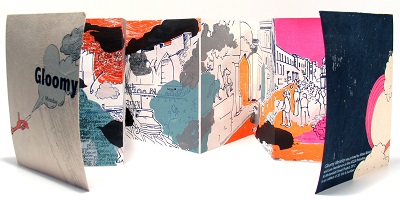
Alison Bianco & Lara Henderson, USA
Gloomy Monday
2012
Letterpress and screen print
5.5 x 4.5” (closed), 5.5 x 34.25” (opened)
Gloomy Monday, printed at the AS220 Community Print shop in Providence, Rhode Island, revisits consequences of evildoing and forecasts an ideal future. Named after the infamous Hungarian suicide song, “Gloomy Sunday”, this book uses familiar symbols, such as city streets, consumer products, and architecture, to help the onlooker forget the past and recall memories only partly true.
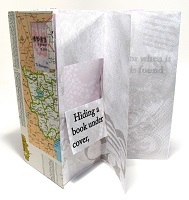 Tia Blassingame, USA
Tia Blassingame, USA
Hers: a primer of sorts
2013; Ed. of 10
Maps, digital printing on Japanese rice paper
4 ½ x 11 1/8”
Hers: a primer of sorts is dedicated to the women for whom education and scholarship are restricted or forbidden. Detailing topography, language, and other basic facts, the discarded almanac pages provide the female protagonist’s cultural and physical landscape. The main text is concealed and revealed just as a woman or girl in any community might hide a book or banned text.
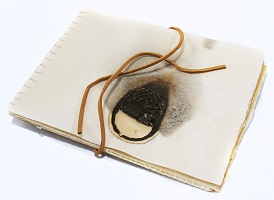 Mare Blocker with Katrina Roberts, USA
Mare Blocker with Katrina Roberts, USA
What’s Left, al-Mutanabbi Street
2013; Ed. of 5
Smoke drawings, burnt and waxed pages
6 x 8.5 x 1”
This collaboration, prompted with the question “how do you repair the irreparable?” draws on the violent action of book burning and the explosion of a car bomb. Pages were altered with fireworks, flares and flames to mimic the incendiary action of the bomb; the mending of the pages signifies the resiliency of the neighborhood, the people and the book form itself.
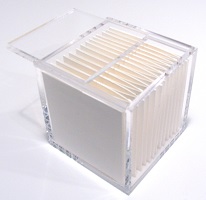 Amaranth Borsuk, USA
Amaranth Borsuk, USA
Sunt Lacrimae Rerum
2013; Ed. of 12
Paper and acrylic box
3 x 3 x 3”
This book takes its title from Aeneas’s words of sorrow uttered before a mural depicting the Trojan War. This reliquary is part lachrymatory: it contains a book whose text is designed to tear away at itself each time the book is displayed. Pleated into an accordion, it plays the elegy for its own effacement as, gradually; the cutout letters catch on one another until they may fall away entirely.
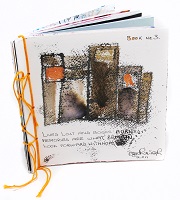 Bound To Be Good Book Group Coordinated by Maureen Astley-Mullen, Jayne H, Cynthia S, Barbara L, Elaine W, Sarah C and Maureen Astley-Mullen, UK
Bound To Be Good Book Group Coordinated by Maureen Astley-Mullen, Jayne H, Cynthia S, Barbara L, Elaine W, Sarah C and Maureen Astley-Mullen, UK
3 of A Kind: Lives Lost, Books Burned Memories, What Remain – Look Forward With Hope
2011; Ed. of 3
Hand painted and collaged
 Denise Brady, USA
Denise Brady, USA
Tangent
2011; Ed. of 40
Handprinted, handmade end sheets paper and clothe over boards, recycled fabrics with paper inclusions that read in Arabic “al-Mutanabbi Street”
6 x 6”
This book was handcrafted every step of the process: mixing pulp; setting the poem; folding, cutting, and pasting paper and clothe; sewing the book. The poem is a reminder that the violence on al-Mutanabbi Street took the lives of individuals who, like each of us, were leading human lives, turning in particular circles of place and time and family. Through language, through writing, through books, we understand that what is personal is universal.
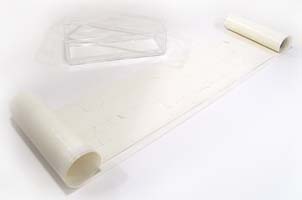 Helga Butzer-Fellesen
Helga Butzer-Fellesen
My Poem Becomes Theirs
 Julie Chen, USA
Julie Chen, USA
Memento
2012; Ed. of 50
Letterpress printed from photopolymer plates
1 9/16 x 2 1/8 x 5/16”
Memento deals with the fragility of the book and the power of reading. It includes a miniature book housed in a wearable locket that allows the reader to wear the book close to the body. The act of carrying a book on one’s person has diverse implications depending on circumstance and place. The locket also holds a triptych that contains a woven token commemorating al-Mutanabbi Street in Iraq: texts on the woven strips taken from the preambles to the constitutions of the United States and Iraq.
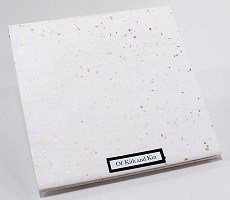
Karen Chew, USA
Of Kith and Kin; Standing Still; Between You and the Sky
2013
Edition: Three unique artist books
“Found poems”, mixed media work, cover weight Classic Crest, mulberry paper, ephemera
6 x 6 x 1/2”
Between You and the Sky reflects upon the fleeting thoughts of yesterday and hopes for recovery. As we heal, we look behind and ahead for guidance with revived hope and promise.
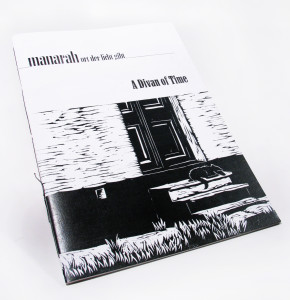 Annette C. Disslin, GERMANY
Annette C. Disslin, GERMANY
Manarah- A Place Shedding Light
2012; Ed. 15-24
Linoprints, woodcuts, letterpress with metal type, hand sewn with black thread
“Manarah” means lighthouse in Arabic, and was used to mean signpost or road mark, while a more general meaning was “a place shedding light” and was later developed into the expression “minaret“, the tower like part of a mosque. Now, the title for Disslin’s new magazine presenting poetry and other writings, which will shed light and give solace, every issue will deal with an issue of “War“, “Time“ and “Love“ present poems that have been written over a period of four centuries.
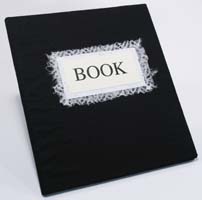 Johanna Drucker, USA
Johanna Drucker, USA
Book
2012
Rives Lightweight, Laser print, and water color
8 x 8 ½”
The premise of this book is simple: take quotes about the value of books from authors of credibility and substance, print them, and then deface the book obliterating the word “book” in every quote. The water coloring resembles blood spattered into the pages the damage increases as the pages progress towards the end. The book is a record of damage, distress, pain, and woundedness.
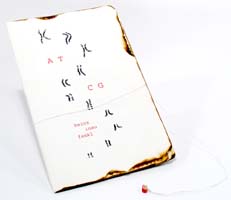 Heinz Insu Fenkl, SOUTH KOREA/USA
Heinz Insu Fenkl, SOUTH KOREA/USA
ATCG
2012-2013
Acid-free sketch paper
5.5 x 8.5 inches
The text of ATCG is 22 pages of the Human Genome sequence. The cover of the handmade shows illustrations from human chromosomes, and is bound with dental floss containing human DNA.
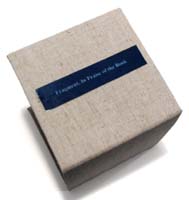
Jesseca Ferguson, USA; INDIA/SUDAN/USA
Fragment, In Praise of the Book
2013; Ed. of 3d
Cyanotype on paper, silk, waxed thread, book board, book cloth
4 x 4 ½ x 4 ½” (closed); 4 x 4 ½ x 13” (open)
Helene Elsborg (box)
NOTE: The book is a sphere of variable dimensions (can be unrolled to be read) made of paper strips, printed with cyanotype (the text of Meena Alexander’s poem), and sewn together.
Fragment, In Praise of the Book is a sphere of text, printed in deep blue cyanotype on white paper, then backed with transparent black silk. In thinking of the origins of the word text, from texere, to weave, the three-dimensional cyanotype transforms Meena Alexander’s poem into one linear element, wound into a ball like yarn. The book becomes a new way to re-tell that story from fragments left after the bombing.
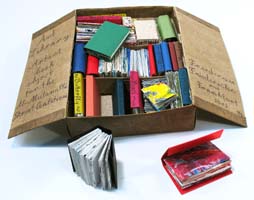 Friederun Friederichs, GERMANY
Friederun Friederichs, GERMANY
Art Library
2012
Book box, miniature books
18 x 24 x 6cm
Art Library centers around the theme that art is a language that does not need translation. It speaks every tongue and makes itself understandable without words, attracts mind and soul by emotion and thought. Art knows no boundaries and can act as a messenger. This artist book object, cut and folded, works like a tiny art library, a bookshelf, a tiny cupboard, and a container for miniature books.
 Bernd Friedrich, GERMANY
Bernd Friedrich, GERMANY
Al-Mutanabbi Street- The Street of Books
2013
Lithographic print, letterpress printing, handmade paper
20 x 13 ½ cm
This book aims to connect Berlin and Baghdad in a way that could be understood by as many people as possible, regardless of language. The pages are printed using lithography and letterpress techniques over a vivid background. Friedrich uses the leporello fold in honor of the street’s poetic namesake.

Gionna Forte-Towaco, USA
For al-Mutanabbi Street
2012; Ed. of 3
Paper, thread
11 ½ x 12”
This edition optimistically focuses on removal, renewal and order. Forte-Towaco uses blown-up photocopies of manipulated Polaroids transferred onto the pages of the book to compose a story of turmoil and revival through juxtaposing images and text. A piece out of every book is cut out to as a sacrifice, and between pages and spine the gold thread represents the support artists have for those suffering.
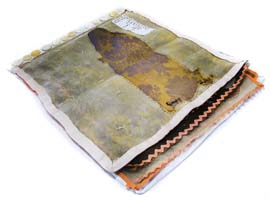 Lahib Jaddo, IRAQ/USA
Lahib Jaddo, IRAQ/USA
Empty
2013; Ed. of 3
Mixed media
16” x 13”
Jaddo’s mixed-media works span nearly three decades and explore the condition of identity, loss/belonging, and the cultural imagery of the “homeland” through the specific lens of the Middle Eastern Diaspora artist. In Jaddo’s work, the notion of homeland is not fixed or static, but a shifting and organic idea that changes according to one’s own emotional states and inner worlds. Whether placed in landscapes of belonging, or negative abstract spaces of isolation, the female figures in Jaddo’s work explore the circumstances of planting roots in a new world, while remaining inextricably connected to another.
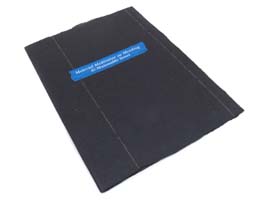 Scott McCarney, USA
Scott McCarney, USA
Material Meditation on Mending al-Mutanabbi Street
2012; Ed. of 50
Indigo digital prints, tar paper
8.5 x 11”
Material Meditation on Mending Al Mutanabbi Street consists of fifteen two-sided loose-leaf prints made from collages constructed with remnants of found books, rubbings from book bindings, and photographs. The leaves are gathered into a tar paper folder like pages picked up in the street and slipped into a convenient sheath. It speaks to themes of reconstruction and memory; of life, literature and culture suspended.
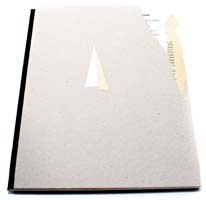 Toby Millman with Kathleen Rashid and Elizabeth Sutton, USA
Toby Millman with Kathleen Rashid and Elizabeth Sutton, USA
Date Due: A Library Book from Detroit to Baghdad
2012; Ed. of 17
Inkjet prints, found paper, double-fan binding
8.5″ x 11″ Toby Millman, Kathleen Rashid, and Elizabeth Sutton perceived a broad connection between the bombing of Al Mutanabbi Street and the neglect and deterioration of their own Detroit area public libraries, still so central to community educational life in inner city neighborhoods. The artists collaborated to create a tribute to the public spaces that provide open access to ideas and communications that survive in spite of the violence and neglect that jeopardize them.
 Bonnie Thompson Norman and Jill Alden Littlewood, USA
Bonnie Thompson Norman and Jill Alden Littlewood, USA
Remember: People of al-Mutanabbi Street
2011; Ed. of 25
Letterpress printed from hand set type, linotype, illustrations from photoengraving, bronze powder
7 ¾ x 4 ½ x 5/8”
This collaboration imagines people standing on al-Mutanabbi Street with their noses in a book, until they were all blown up. The books survived, but the people didn’t, thus Remember: People of al-Mutanabbi Street is a book of beauty, where the lives lost can live forever. Its distressed pages carry the dust of war and convey the sadness felt after the bombing.
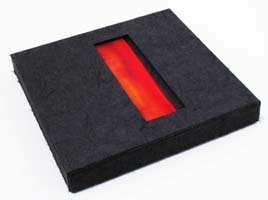 Bettina Pauly, GERMANY/USA
Bettina Pauly, GERMANY/USA
A sun that rises
2013; Ed. of 10
BFK paper, soft Unryu paper, Mulberry paper, hand dyed silk
Ribbon, Machine stitching, abstract etching, letterpress printed, digitally set in Garamond using photopolymer plates
6 x 5 ¾ x 4 ½” (extended); 6 3/8 x 6 x 7/8” (box)
The text for A sun that rises comes from the documentary about the al-Mutanabbi Street bombing, A Candle for Shabandar Cafe, by Emad Ali. It talks about cruel violence persisting over centuries, and ends in saying: ‘There is still a sun that rises and there is hope despite all the destruction’. The color choice for the book evokes the destruction, smoke, and blood while the ribbon evokes the color of the sunrise, seen through air thick with smoke.
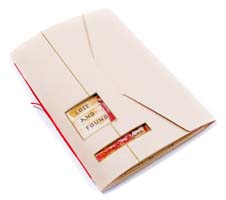 Maria G. Pisano, USA
Maria G. Pisano, USA
LOST and FOUND
2011; Open Edition
Laser printed with gold paint
7 x 5 x 1 inches
LOST and FOUND reflects on the history of the Middle East. Symbolic fragments were collected and reassembled with historical text and maps, to illustrate the area’s rich cultural heritage of the area. The book hopes to raise awareness of lost lives, cultural property, and the freedom to openly share and discuss ideas.
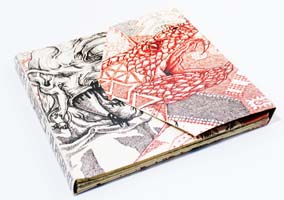
Michael Pisano with Marie Pisano, USA
Seven Voyages
2012; Open Edition
Accordion book, Hahnemuhle Gutenberg laid paper, archival inks, wrapper with envelope flap, original illustrations in pen and ink
11 x 7 inches
Seven Voyages, illustrated in pen and ink by Michael Pisano and designed by Maria G. Pisano, was inspired by the story of Sinbad the Sailor. It seeks to honor the ability of books and stories to share universal legends that connect cultures and enrich humanity and allow readers to travel to distant and exotic lands.
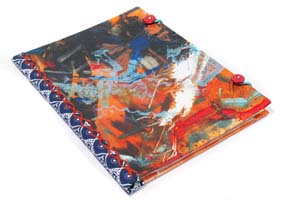 Bev Samler, UK
Bev Samler, UK
Scavenged
2013
Dry point etching, collage, mixed media
205 x 155 mm
Scavenged recreates the scene prior to the deprivation and scavenging attacks on al-Mutanabbi Street, and attempts to restore the to its former glory. Fred Norman’s words written throughout reinforce the necessity for varied, intellectual thoughts and written word.
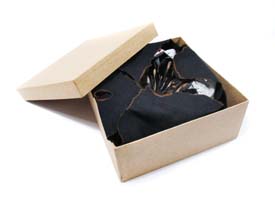
Dina Scheel, USA
The Cycle of Censorship
2012; Ed. of 25
Tyvek, found papers, linen thread, acrylic paint, cotton linen material
7 x 3 inches
An origami form called Fireworks was modified to make The Cycle of Censorship a moveable book that rotates through its center to tell its story. The story starts with an act of censorship – like a bombing – but the ideas (gold) emerge and spread as the book rotates, which then spawns more ideas, alarming people and causing more censorship (black). The cycle begins anew.
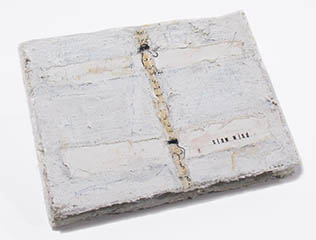 Naomi Sultanik, USA/NETHERLANDS
Naomi Sultanik, USA/NETHERLANDS
Slow Wind
2012; Ed. of 3
Mixed media, ink- jet prints of collage, drawings, text
20 x 15 x 2cm
Slow Wind is a reference to the inevitability and process of change. Conceived as book object, Sultanik inter-mingled tactile, abstract and textual elements to reflect upon personal journeys, reading and encounters; the banalities that acknowledge our existence.
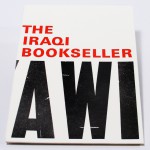 Laurie Szujewska, USA
Laurie Szujewska, USA
The Iraqi Bookseller
2012; Ed. of 20
Timeworn wood types and Universe foundry type letterpress printed in red, green, and black inks on Rives BFK
7 3/4 x 5 11/16” (closed); 15 x 22” (open)
The Iraqi Bookseller is inspired by The Bookseller’s Story Ending Much too Soon, an article written by Anthony Shadid for the Washington Post Foreign Service on March 12, 2007. The book is intended to be both a remembrance of Hayawi and a tribute to Shadid’s poignant story of his friend. Sadly, as I was finishing the printing, Anthony Shadid died on February 13, 2012, while in Syrian covering the uprising there.
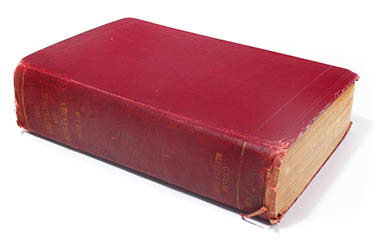 Linda Toigo, USA
Linda Toigo, USA
H.G. Wells
Ex-votos: altered books
2012; Ed. of 3
Inkjet printing on altered book
9.5 x 11 x 2”
The three altered books, different editions of H.G. Wells’ History of the World, are titled after votive offerings that cover the walls of certain churches in Southern Europe and South America. Meant to be symbolic and sacred, the medical images of hearts are carved into the books to reveal the objects’ volumetric and material qualities. The history doesn’t follow a chronological order: the eye is drawn through the holes and deep into the space carved by the scalpel to connect events.
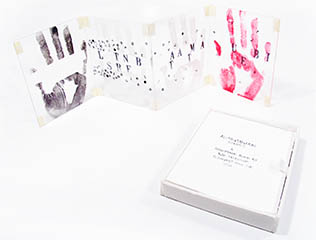 Rae Trujillo, USA
Rae Trujillo, USA
Al-Mutanabbi Street
2012; Ed. of 10
Plexiglas, ink, adhesive bandages
5 x 6”
Layered with meaning, from a black handprint of oppression, red for the blood shed, and white for the future and what is possible, al-Mutanabbi Street remains transparent. The handprints, layered when the book is closed and individually exposed when the accordion folds out, invite anyone from any language or background to feel what happened, and keep the street alive.
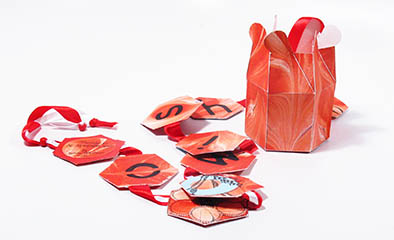 Sylvia Warham, UK
Sylvia Warham, UK
Mandalas for al-Mutanabbi Street
2011
Mandalas encourage meditations on the dead, the loss of ancient scholarly works, the loss of an intellectual community and the hopes and good wishes for its revival. The white ribbon symbolizes the thin thread of humanity, while red shows the intellectual and creative powers that bind all artists and writers to al-Mutanabbi Street. The box is hand marbled with flowing patterns, symbolic of the flow of thoughts between all who meditate on the mandalas.
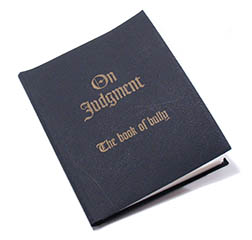 Nanette Wylde, USA
Nanette Wylde, USA
On Judgment: The book of bully
2012, Ed. 17
Wood relief on Somerset
5.75 x 4.625 x .625”
Creating more questions than answers, Wylde considers parallels and relationships to work through the cause of the destruction of Al-Mutanabbi Street. The book communicates the complexity of the content, and the Wood relief provides the pages with a hand-printed aesthetic, which reflects the history of books, the printed word, and the street itself.
Prints and Broadsides
Peter Annand
Passages
Nina Arder
Bombs Bombs
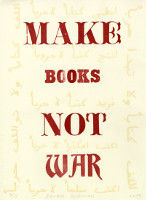 Printer: Sarah Bodman
Printer: Sarah Bodman
Calligraphy: Nadia Chalabi
Translator: Nejat Chalabi
Make Books Not War
Letterpress with laser etching. Edition of 15.
I first heard about the project when Beau Beausoleil contacted me at the recommendation of Steve Woodall at SFCB. I am really pleased that Steve said to get in touch as this is such a great idea. The Make Books Not War text on the broadside was translated into Arabic by Nejat Chalabi and handwritten by Nadia Chalabi to scan and then laser etch into the paper. I wanted to make something that conveyed the message very easily. The letterpress text is meant to look like the old Western “wanted” posters. I asked my friend Nadia Chalabi, who has also produced a broadside, if her mother could translate the text into Arabic for me; these are the variations that arose:
Make Books Not War
Make a book and do not make war
Be the author of a book and not the author of wars
We want books not wars
Give me a book not war
Produce books not wars
Write your thoughts and do not make war
Write for peace and do not write for war
I think that just about sums it all up.
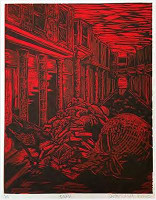 Justus Evans, San Quentin Prison, CA
Justus Evans, San Quentin Prison, CA
IQRA, 2015
Linocut
“IQRA” : My print is telling about the connection between Knowledge and Death. How no matter what culture you study Death seeks out those who seek the Truth in Knowledge. Allah subhana wa ta ‘ala sai “Iqra”, Read!
 Christine Felce, UK
Christine Felce, UK
For Al Mutanabbi Street
Screenprint
I was invited to make a print entitled ‘For Al Mutanabbi Street’ Where is Al Mutanabbi street exactly? What is the history behind this conflict? What about Assyrian culture? How did borders get split up? I had so many questions. I had seen the war, the bombings, the army and the oil refineries on the TV. My personal impressions of Baghdad were from children’s story books; flying carpets and the glamorous Hollywood images of The Thief of Baghdad. I wanted to use a medium that would reflect layers so that the printing process could reflect, in some way, the layers of events behind the conflict in Iraq. I chose screen printing because it can incorporate many layers. I would be like a detective collecting information and laying it down.
A map was my starting point. This would show me exactly the area where the street of booksellers had been. The Internet provided many maps of a city divided by different ethnic groups. I chose an old map. A map needs a base to stand its streets and houses on. I had already been creating work for an exhibition called ‘paper memories’ where I had collected rubbings from tree stumps, bark, paving stones, floors and natural surfaces. Surfaces that have not changed for thousands of years.
I had been working on a series entitled ‘ For…’ as part of the paper memories exhibition. ‘For ‘ commemorated personal and important events that happened for me in 2014. During this time my brother died of cancer. I wanted to make a piece of work entitled ‘ For David’ to help me cope with the loss, it felt right to make ‘ For Al Mutanabbi Street’ part of this series.
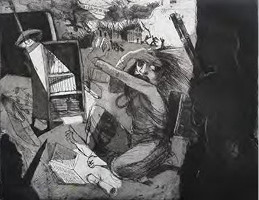 Marcelle Hanselaar, UK
Marcelle Hanselaar, UK
The Bookseller’s Daughter I
Etching
Made in response to the Al Mutanabbi Street bombing and also in memory of my father who was an antiquarian bookseller. I hope these prints will in a small way bring the bombed street with its cultural hub back to life. I like the idea that we collectively as artists, writers and poets create a travelling, continuously changing fluid street for anyone to visit, to browse, to discuss, to reflect. Just as it ever was.
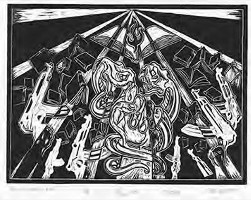 Ray Ho, San Quentin State Prison, CA, USA
Ray Ho, San Quentin State Prison, CA, USA
Behold Good and Evil, 2014
Linocut
A very prolific artist, Ray was able to finish this print just before his release from San Quentin State Prison in California.
Raluca Ianca
Up in Smoke
Ellen Knudson
CNTR-L
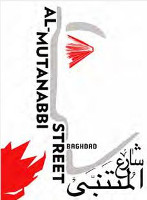 Mokhtar Paki, USA
Mokhtar Paki, USA
Al Mutanabbi Street, Baghdad, 2014
Screenprint
This is very straightforward work, as clear as the contrast between the violence and human dialogue, between burning fire and education, and between bomb and book. Best luck for Baghdad rationalists against fundamentalists and warmongers.
Brend W. Platke
And One with a Heavy Load
 Printer: Gary Price
Printer: Gary Price
Author: Al-Mutanabbi
Glory and Honor be Restored
In creating Glory and Honor, I sought to relate both to what had happened on March 5, 2007, on Al-Mutanabbi Street and to its long history. What better place to start in attempting to express my sentiments than with the words of al Mutannabi? As to the image, it seeks again to relate to what the street represents as well as to the event that has brought it to our attention.
In creating Glory and Honor, I sought to relate both to what had happened on March 5, 2007, on Al-Mutanabbi Street and to its long history. What better place to start in attempting to express my sentiments than with the words of al Mutannabi? As to the image, it seeks again to relate to what the street represents as well as to the event that has brought it to our attention.
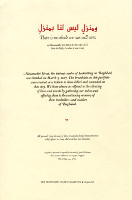 Printer: Lisa Rappoport
Printer: Lisa Rappoport
Author: Al-Mutanabbi
There Is No Abode We Can Call Ours
Letterpress. Edition of 10.
This is the title page to the boxed Al-Mutanabbi Street Starts Here broadside portfolio collection.
 Author and Printer: Janet Rodney
Author and Printer: Janet Rodney
The Twisted
Letterpress. Edition of 25.
It has not been my habit as a printer over the years to make a statement about what I do. It has been my impression that the work speaks for itself; whatever explanation describing the process being contained in the colophon. Al-Mutanabbi Broadside Project is an exception, however. The reason for participating is an Undying Belief that violence is never an acceptable solution to human discord, and that Art created specifically as an alternative view, can make a difference in that regard. The poem was written in 2009, part of a series untitled as yet. The type used on the broadside is Palatino Italic foundry type, printed on Domestic Etching paper. The image is a rainbow roll of black and red printed from a magnesium photoengraving. The image itself originates from a digital photograph of tail lights taken through a car window at dusk.
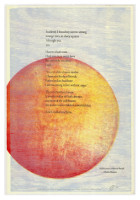 Printer: Greg Shattenberg
Printer: Greg Shattenberg
Author: Khaled Mattawa
Adolescence of Burnt Hands
Letterpress; poem in black ink.
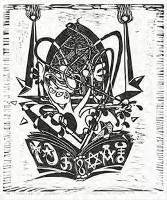 Frederick P. Tinsley, USA
Frederick P. Tinsley, USA
Mutanabbi St. Explosion 2007, 2014
Linocut
Live and let live.
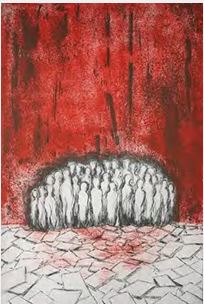 Elaine Winter, UK
Elaine Winter, UK
We will always make another
Etching with drypoint
I had a year to make this print, which sounded like a long time when I decided to join with the other artists, writers and poets that have responded so far. I was initially contacted by the UK coordinator Catherine Cartwright. Why did I decide to take part? Catherine sent me some material to read plus a series of photographs from the bookseller’s district. The images were the deciding factor: portraits of a community sharing stories that was then brutally shattered. A friend of mine said (very wisely) that our story is what makes us who we are; we are not who we are without our stories. How true. All our stories need to be kept alive and the community that shares them needs to be rebuilt when it is blown apart.
Over the year I have read the extraordinary contents of the book ‘Al-Mutanabbi Street Starts Here’, I went to see the exhibition of art books and broadsheets at The Mosaic Rooms in London. I also, like everyone else, have had a year punctuated by hearing news from Iraq that is unbearably hard to hear and impossible to make sense of, but I am listening to that news from the safe comfort of peace. This work made me acutely aware of that contrast.
Beau Beausoleil, poet, bookseller and founder of the Al- Mutanabbi Street Starts here movement has provided encouraging words to those of us responding. He encouraged us to ‘’struggle with the ideas…discard what comes easy…’’ Struggling with the ideas was always going to be part of the deal with this print but what about discarding what comes easy? I decided to embrace the ethos of the project and not rely on methods for making prints that I have used for previous work. Instead I tried techniques that were new to me and embarked on working with non-toxic etching.
